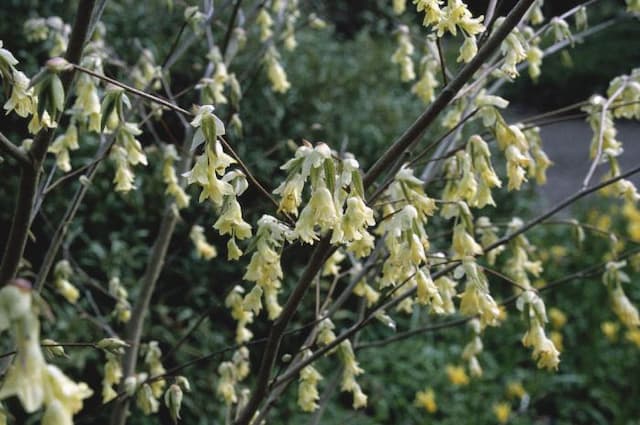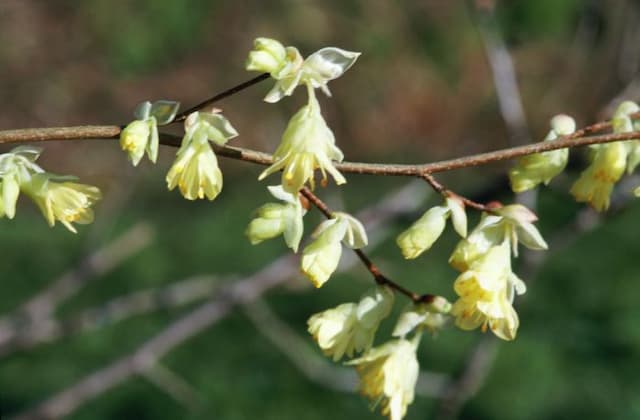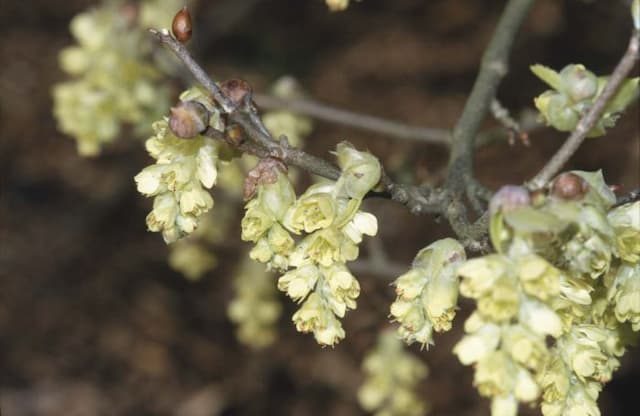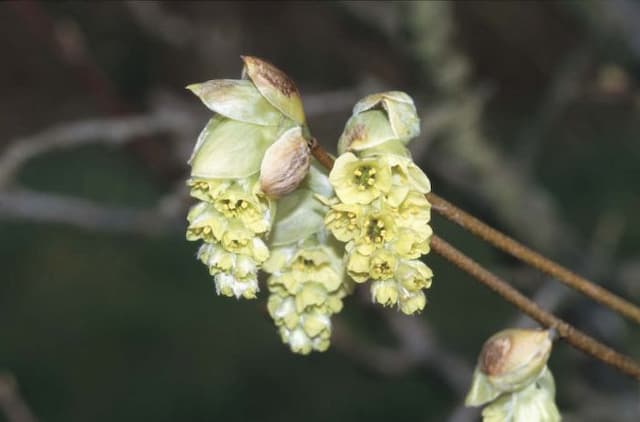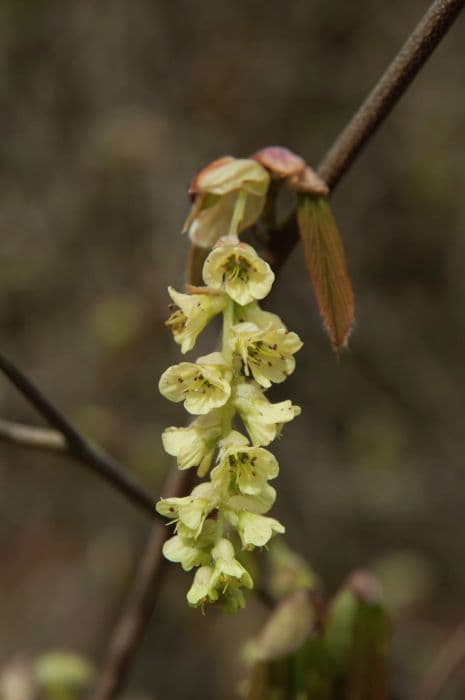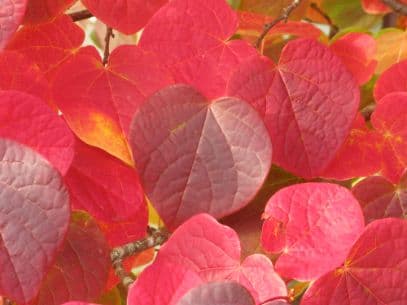Chinese Winter Hazel Corylopsis sinensis var. calvescens

ABOUT
The plant, commonly known as Chinese winter hazel, has a distinctive appearance characterized by its graceful, arching branches that create an open, spreading form. During early spring, it produces clusters of small, bell-shaped yellow flowers that hang delicately from the branches, adding a burst of color before the leaves emerge. These flowers often have a soft, sweet fragrance, which adds to the plant's charm. Following the bloom of flowers, the plant produces leaves that are generally oval-shaped with a pointed tip, and the edges are subtly toothed. The foliage has a fresh, bright green color when young and matures to a deeper green as the season progresses. In fall, these leaves transform, taking on shades of yellow to add a touch of autumn beauty. The bark of the Chinese winter hazel contributes to its ornamental value with its smooth, grayish-brown color that provides a nice contrast to the vibrant hues of its leaves and flowers. The overall look of the plant is one of serene beauty, with its elegant shape and seasonally changing palette making it a valuable addition to any garden landscape, where it can provide visual interest throughout the year.
About this plant
 Names
NamesFamily
Hamamelidaceae
Synonyms
Chinese Winter Hazel, Fragrant Winter Hazel
Common names
Corylopsis calvescens, Corylopsis sinensis f. calvescens.
 Toxicity
ToxicityTo humans
Corylopsis, also known as winter hazel, is not widely known for being toxic to humans. There is limited information available on any toxicity it may have when ingested. However, as with any plant material, consumption is not advised, and sensitive individuals may experience adverse reactions. If any part of the plant is ingested and symptoms appear, seeking medical advice is recommended.
To pets
Winter hazel is not commonly listed as a toxic plant to pets. However, the lack of specific data means that caution should be exercised. As with humans, ingestion of plant material by pets is generally discouraged, and if any signs of illness appear after ingestion, it is advisable to contact a veterinarian.
 Characteristics
CharacteristicsLife cycle
Perennials
Foliage type
Deciduous
Color of leaves
Green
Flower color
Yellow
Height
6 feet (1.83 meters)
Spread
6 feet (1.83 meters)
Plant type
Shrub
Hardiness zones
7
Native area
China
Benefits
 General Benefits
General Benefits- Aesthetic Appeal: Adds visual interest to gardens with its attractive pendulous yellow flowers in early spring.
- Seasonal Interest: Early bloomer that provides color and interest in late winter to early spring when few other plants are in bloom.
- Habitat Support: Offers nectar to early-season pollinators such as bees.
- Diverse Landscaping: Can be used in various landscape designs, including as a specimen shrub, in mixed borders, or woodland gardens.
- Fall Coloration: Provides autumn interest with its leaves turning shades of yellow and orange.
- Low Maintenance: Requires minimal pruning and is relatively easy to care for once established.
- Wildlife Friendly: Bears fruit that can provide food for birds and other wildlife.
- Shade Tolerance: Can grow well in partial shade, making it versatile for different garden locations.
 Medical Properties
Medical PropertiesThis plant is not used for medical purposes.
 Air-purifying Qualities
Air-purifying QualitiesThis plant is not specifically known for air purifying qualities.
 Other Uses
Other Uses- Corylopsis sinensis var. calvescens, commonly known as Chinese winter hazel, can be used as a natural dye for fabrics, yielding colors ranging from yellow to green depending on the mordant used.
- The wood of Chinese winter hazel can be utilized in fine woodworking or for crafting small decorative objects due to its fine grain and workability.
- The fragrant flowers of Chinese winter hazel can be used in the production of natural perfumes or scented oils, providing a unique fragrance base.
- Chinese winter hazel's branches and twigs can be incorporated into floral arrangements, adding a rustic and natural aesthetic to various decorations.
- Leaves from the Chinese winter hazel can serve as a natural insect repellent when crushed and released, due to their aromatic properties.
- In landscape gardening, Chinese winter hazel can be used as a natural screen or hedge, offering privacy and wind protection with its dense foliage.
- The plant can be used as a natural food source for wildlife, providing sustenance to birds and small mammals with its seeds during colder months.
- Dried branches of Chinese winter hazel can be used in crafts, such as wreath making, adding both structure and a hint of natural beauty to the final product.
- Chinese winter hazel sap can be used as a natural adhesive or binding agent in traditional handicrafts, though not as strong as commercial glues.
- The plant’s leaves can also be utilized in creating botanical prints on paper or fabrics, a technique used in art and DIY crafting projects to transfer the leaf patterns and shapes.
Interesting Facts
 Feng Shui
Feng ShuiThe plant Chinese winter hazel is not used in Feng Shui practice.
 Zodiac Sign Compitability
Zodiac Sign CompitabilityThe plant Chinese winter hazel is not used in astrology practice.
 Plant Symbolism
Plant Symbolism- Spring Rejuvenation: Corylopsis sinensis var. calvescens, commonly known as Chinese winter hazel, often blooms early in the year, symbolizing the reawakening of nature and new beginnings.
- Hope: The bright yellow flowers emerging before the leaves are fully developed are a sign of hope and joy after the long winter months.
- Delicate Beauty: The intricate, fragrant blossoms represent the appreciation of subtle and delicate beauty in our lives.
- Purity: The clear yellow of the flowers can be symbolic of purity and innocence.
- Welcoming: Chinese winter hazel's early and beautiful blossoms can symbolize hospitality, welcoming spring and its visitors to the garden.
 Water
WaterFor the Chinese Winter Hazel, it is best to maintain a consistently moist soil without it being waterlogged. Water the plant when the top inch of the soil feels dry to the touch, which typically means watering every 7 to 10 days, depending on the climate and the environment. During active growth in the spring and summer months, you may need to water more frequently. If you are watering a potted Chinese Winter Hazel, ensure that the pot has drainage holes and use approximately 1 gallon of water, ensuring excess water drains out. During the winter, reduce watering to every 2 to 3 weeks, as the plant's water requirements decrease.
 Light
LightThe Chinese Winter Hazel thrives best in partial shade to full sun. This means it should be placed in a spot where it can receive bright, indirect light for the majority of the day, or direct sunlight for only a part of the day. Avoid exposing the plant to prolonged periods of intense midday sun, as this can lead to leaf scorch.
 Temperature
TemperatureChinese Winter Hazel prefers moderate temperatures, ideally between 60 to 75 degrees Fahrenheit. It can withstand brief periods outside its preferred range, with a maximum temperature tolerance around 90 degrees Fahrenheit and a minimum temperature tolerance down to around 20 degrees Fahrenheit. The plants are deciduous and therefore can manage cooler temperatures in the dormant winter season, but should not be exposed to extreme cold for prolonged periods.
 Pruning
PruningPrune the Chinese Winter Hazel to maintain its shape and encourage healthy growth. The best time to prune is in late winter or early spring before new growth starts. Thin out old branches and remove any dead, damaged, or diseased wood. Pruning yearly or once every two years will help to rejuvenate the plant and maintain a tidy appearance.
 Cleaning
CleaningAs needed
 Soil
SoilThe Chinese winter hazel prefers well-drained, loamy soil rich in organic matter. It thrives in acidic to slightly acidic pH levels, ranging from 5.5 to 6.5. A mixture containing equal parts of garden soil, peat moss, and perlite or sand would create an ideal environment for its roots, ensuring proper drainage and aeration.
 Repotting
RepottingChinese winter hazel does not need frequent repotting; it should typically be repotted every 2-3 years or when it outgrows its current pot. This timing allows the plant to establish itself without being stressed by too frequent disturbances.
 Humidity & Misting
Humidity & MistingChinese winter hazel prefers moderate to high humidity levels. While it can tolerate some dryness, maintaining indoor humidity around 40-60% is ideal for the health of the plant.
 Suitable locations
Suitable locationsIndoor
Provide bright indirect light and maintain high humidity.
Outdoor
Plant in partial shade, shelter from harsh winds, and mulch.
Hardiness zone
7-9 USDA
 Life cycle
Life cycleCorylopsis sinensis var. calvescens, commonly known as Chinese winter hazel, initiates its life cycle as a seed, which after a period of dormancy, typically requires stratification to break dormancy and promote germination. Upon germination, seedlings develop, forming a root system and cotyledons, followed by true leaves, as the plant enters its vegetative growth stage. As the Chinese winter hazel matures, it develops woody tissue and branches, entering the sapling phase and eventually becoming a mature shrub. Flowering occurs in early to mid-spring before the leaves fully emerge, with the plant producing drooping, fragrant yellow flowers that attract pollinators. After pollination, the flowers develop into small capsules containing seeds, which upon maturation, are dispersed to begin a new cycle. In the absence of environmental or biological stress, the Chinese winter hazel can continue this cycle for many years, going through periodic growth and dormancy with the changing seasons.
 Propogation
PropogationPropogation time
Spring
The Chinese Winter Hazel can be propagated by softwood cuttings taken in late spring or early summer. To do this, select a healthy, non-flowering stem and cut a piece around 4 to 6 inches (10 to 15 cm) long, ensuring there are at least two to three sets of leaves. Remove the lower leaves and dip the cut end into rooting hormone to encourage root development. Plant the cutting in a pot filled with a mix of peat and perlite or sand, ensuring the remaining leaves are above the soil surface. Cover the pot with a plastic bag or place it in a greenhouse to maintain humidity, and keep it in a warm spot with indirect light. Roots typically develop within a few weeks, after which the cutting can be gradually acclimatized to the outside environment before being planted in its final location.
